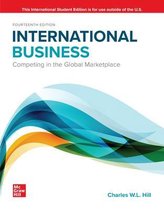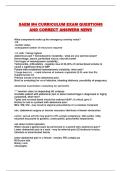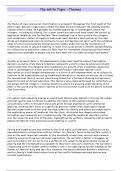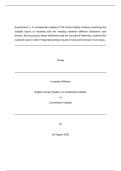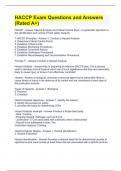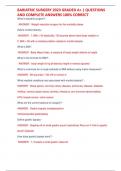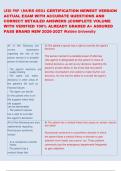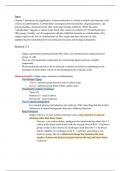International Management
WEEK 1
LECTURE & LITERATURE
Exporting
- More than 90 percent of all companies are engaged in the global marketplace export.
o Low commitment
o Preferred by many small and medium-sized enterprises.
- Increased volume of exporting is facilitated by:
o A decline in trade barriers and increase in regional economic agreements.
o Advances in technology and communication.
- The prospect of exporting is intimidating for some firms.
The promises and risks associated with exporting:
- Large revenue and profit opportunities in foreign markets for most firms.
- Economies of scale.
- Large firms tend to be proactive about exporting, while medium-sized and small firms
tend to be reactive.
- Unfamiliar or intimidated by foreign market opportunities.
A barrier to exporting is the simple lack of knowledge of the opportunities available.
- It is needed to collect information on how different countries operate.
- Other countries might have more experience in trade (e.g., Japan or Germany).
o MITI (Ministry of International Trade and Industry).
o Sogo shosha (general trading companies). Proactively seek export
opportunities for their affiliated companies.
Despite institutional disadvantages, US firms can increase their awareness of export
opportunities:
- US Department of Commerce.
o US and Foreign Commercial Service and International Trade Administration
(ITA).
o District Export Councils.
- Small Business Administration (SBA)
, o Small Business Development Centres (SBDC), Service Corps of Retired
Executives (SCORE), and Export Legal Assistance Network (ELAN).
- Centres of International Business Education and Research.
Export-import service providers:
- Freight forwarders
o Orchestrate transportation for companies that are shipping internationally.
o Combine smaller shipments into a single large shipment to minimize the
shipping cost.
o Handle documentation, payment, and carrier selection.
- Export management companies (EMC)
o Deal with export documents and operate as the firm’s agent and distributor.
o Handle all aspects of exporting.
- Export trading companies
o Provide comprehensive exporting services, including export documentation,
logistics, and transportation.
- Export packaging companies
o Advise companies on appropriate design and materials for the packaging of
their items.
o Assist companies in minimizing packaging to maximize the number of items to
be shipped.
- Customs brokers
o Can help companies avoid pitfalls in customs regulations.
o Offer a firm a complete package of services that is essential in dealing with
potential pitfalls when a firm is exporting to a large number of companies.
- Confirming houses (buying agents)
o Represent foreign companies that want to buy your products.
- Export agents, merchants, and remarketers
o Buy products directly from the manufacturer and package and relabel the
products.
o Small effort to market internationally, but you lose control.
- Piggyback marketing
o One firm distributes another firm’s products.
o Usually requires complementary products and the same target market of
customers.
- Economic processing zones (EPZs)
o Include foreign trade zones (FTZs), special economic zones, bonded
warehouses, free ports, and customs zones.
o Used to receive shipments of products that are then reshipped in smaller lots
to customers throughout surrounding areas.
,Export Strategy
1. Hire an EMC or at least an experienced export
consultant to identify opportunities and navigate the
paperwork and regulations in exporting.
2. Initially focus on one market or a handful of markets.
3. Enter a foreign market on a small scale to reduce the
costs of any subsequent failure.
4. Recognize the time and managerial commitment
involved in building export sale and hire additional
personnel to oversee this activity.
5. Devote attention to building strong and enduring
relationships with local distributors and/or customers.
6. Hire local personnel to help the firm establish itself in a
foreign market.
7. Be proactive about seeking export opportunities.
8. Retain the option of local production. (Exporting is often not an end in itself but merely
a step on the road toward establishment of foreign production.)
Firms engaged in international trade have to trust someone they may have never seen, who
lives in a different country, who speaks a different language, who abides by (or does not
abide by) a different legal system, who could be very difficult to track down is he or she
defaults on an obligation.
Due to the lack of trust between two parties, each has his own preferences as to how the
transaction should be configured. To make
sure he is paid, the exporter would prefer
the importing firm to pay before the
products are shipped. Alternatively, to
ensure the firm receives the product, they
would prefer not to pay for them until they
arrive.
This problem is solved by using a third party
trusted by both – normally a reputable bank
– to act as an intermediary.
Export and import financing – three key documents for financing international trade.
Letter of Credit (L/C)
- States that the bank will pay a specified sum of money to the exporter, on
presentation of particular, specified documents.
- Issued by a bank at the request of the importer.
- Companies are likely to trust reputable banks.
- The importer must pay a fee.
Draft (Bill of Exchange)
- Normally used in international commerce to effect payment.
- An exporter (maker) instructing an importer(‘s agent) (drawee) to pay a specified
amount of money at a certain time.
, - Used to settle trade transactions:
o In domestic transactions, the buyer can often obtain possession of the
merchandise without signing a formal document acknowledging his obligation
to pay.
o In international transactions, payment or a formal promise to pay is required
before the buyer can obtain the merchandise.
- Sight draft: payable on presentation to the drawee.
- Time draft: allows for a delay in payment.
o When a time draft is drawn on and accepted by a bank, it is called a banker’s
acceptance.
o When it is drawn on and accepted by a business firm, it is called a trade
acceptance.
o Negotiable instruments – once the draft is stamped with acceptance, the
maker can sell the draft to an investor at a discount from its face value.
Bill of Lading
- Three purposes:
o Receipt: indicates that the carrier has received the merchandise described on
the face of the document.
o Contract: it specifies that the carrier is obligated to provide transportation
service in return for a certain charge.
o Document of title: to obtain (a written promise of) payment before the
merchandise is released to the importer.
- Can also function as collateral against which funds may be advanced to the exporter
by its local bank before or during shipment and before final payment by the importer.
Export Assistance
Export-Import Bank:
- Assists in the financing of US exports of products and services to support US
employment and market competitiveness.
- Supplements private capital lending with various loan and loan-guarantee programs.
o Guarantees repayment of medium- and long-term loans that US commercial
banks make to foreign borrowers for purchasing US exports.
o Also lends dollars to foreign borrowers for use in purchasing US exports.
Export Credit Insurance:
- The lack of a letter of credit exposes the risk that the foreign importer will default on
payment.
- The exporter can insure against this possibility by buying export credit insurance.
Provided by the Foreign Credit Insurance Association (FCIA).
Countertrade: an alternative means of structuring an international sale when conventional
means of payment are difficult, costly, or non-existent.
- Popular among developing nations that lack the foreign exchange reserves required
to purchase necessary imports.
- World trade covered by some sort of countertrade agreement range from highs of 8
and 10 percent by value to lows of around 2 percent.
WEEK 1
LECTURE & LITERATURE
Exporting
- More than 90 percent of all companies are engaged in the global marketplace export.
o Low commitment
o Preferred by many small and medium-sized enterprises.
- Increased volume of exporting is facilitated by:
o A decline in trade barriers and increase in regional economic agreements.
o Advances in technology and communication.
- The prospect of exporting is intimidating for some firms.
The promises and risks associated with exporting:
- Large revenue and profit opportunities in foreign markets for most firms.
- Economies of scale.
- Large firms tend to be proactive about exporting, while medium-sized and small firms
tend to be reactive.
- Unfamiliar or intimidated by foreign market opportunities.
A barrier to exporting is the simple lack of knowledge of the opportunities available.
- It is needed to collect information on how different countries operate.
- Other countries might have more experience in trade (e.g., Japan or Germany).
o MITI (Ministry of International Trade and Industry).
o Sogo shosha (general trading companies). Proactively seek export
opportunities for their affiliated companies.
Despite institutional disadvantages, US firms can increase their awareness of export
opportunities:
- US Department of Commerce.
o US and Foreign Commercial Service and International Trade Administration
(ITA).
o District Export Councils.
- Small Business Administration (SBA)
, o Small Business Development Centres (SBDC), Service Corps of Retired
Executives (SCORE), and Export Legal Assistance Network (ELAN).
- Centres of International Business Education and Research.
Export-import service providers:
- Freight forwarders
o Orchestrate transportation for companies that are shipping internationally.
o Combine smaller shipments into a single large shipment to minimize the
shipping cost.
o Handle documentation, payment, and carrier selection.
- Export management companies (EMC)
o Deal with export documents and operate as the firm’s agent and distributor.
o Handle all aspects of exporting.
- Export trading companies
o Provide comprehensive exporting services, including export documentation,
logistics, and transportation.
- Export packaging companies
o Advise companies on appropriate design and materials for the packaging of
their items.
o Assist companies in minimizing packaging to maximize the number of items to
be shipped.
- Customs brokers
o Can help companies avoid pitfalls in customs regulations.
o Offer a firm a complete package of services that is essential in dealing with
potential pitfalls when a firm is exporting to a large number of companies.
- Confirming houses (buying agents)
o Represent foreign companies that want to buy your products.
- Export agents, merchants, and remarketers
o Buy products directly from the manufacturer and package and relabel the
products.
o Small effort to market internationally, but you lose control.
- Piggyback marketing
o One firm distributes another firm’s products.
o Usually requires complementary products and the same target market of
customers.
- Economic processing zones (EPZs)
o Include foreign trade zones (FTZs), special economic zones, bonded
warehouses, free ports, and customs zones.
o Used to receive shipments of products that are then reshipped in smaller lots
to customers throughout surrounding areas.
,Export Strategy
1. Hire an EMC or at least an experienced export
consultant to identify opportunities and navigate the
paperwork and regulations in exporting.
2. Initially focus on one market or a handful of markets.
3. Enter a foreign market on a small scale to reduce the
costs of any subsequent failure.
4. Recognize the time and managerial commitment
involved in building export sale and hire additional
personnel to oversee this activity.
5. Devote attention to building strong and enduring
relationships with local distributors and/or customers.
6. Hire local personnel to help the firm establish itself in a
foreign market.
7. Be proactive about seeking export opportunities.
8. Retain the option of local production. (Exporting is often not an end in itself but merely
a step on the road toward establishment of foreign production.)
Firms engaged in international trade have to trust someone they may have never seen, who
lives in a different country, who speaks a different language, who abides by (or does not
abide by) a different legal system, who could be very difficult to track down is he or she
defaults on an obligation.
Due to the lack of trust between two parties, each has his own preferences as to how the
transaction should be configured. To make
sure he is paid, the exporter would prefer
the importing firm to pay before the
products are shipped. Alternatively, to
ensure the firm receives the product, they
would prefer not to pay for them until they
arrive.
This problem is solved by using a third party
trusted by both – normally a reputable bank
– to act as an intermediary.
Export and import financing – three key documents for financing international trade.
Letter of Credit (L/C)
- States that the bank will pay a specified sum of money to the exporter, on
presentation of particular, specified documents.
- Issued by a bank at the request of the importer.
- Companies are likely to trust reputable banks.
- The importer must pay a fee.
Draft (Bill of Exchange)
- Normally used in international commerce to effect payment.
- An exporter (maker) instructing an importer(‘s agent) (drawee) to pay a specified
amount of money at a certain time.
, - Used to settle trade transactions:
o In domestic transactions, the buyer can often obtain possession of the
merchandise without signing a formal document acknowledging his obligation
to pay.
o In international transactions, payment or a formal promise to pay is required
before the buyer can obtain the merchandise.
- Sight draft: payable on presentation to the drawee.
- Time draft: allows for a delay in payment.
o When a time draft is drawn on and accepted by a bank, it is called a banker’s
acceptance.
o When it is drawn on and accepted by a business firm, it is called a trade
acceptance.
o Negotiable instruments – once the draft is stamped with acceptance, the
maker can sell the draft to an investor at a discount from its face value.
Bill of Lading
- Three purposes:
o Receipt: indicates that the carrier has received the merchandise described on
the face of the document.
o Contract: it specifies that the carrier is obligated to provide transportation
service in return for a certain charge.
o Document of title: to obtain (a written promise of) payment before the
merchandise is released to the importer.
- Can also function as collateral against which funds may be advanced to the exporter
by its local bank before or during shipment and before final payment by the importer.
Export Assistance
Export-Import Bank:
- Assists in the financing of US exports of products and services to support US
employment and market competitiveness.
- Supplements private capital lending with various loan and loan-guarantee programs.
o Guarantees repayment of medium- and long-term loans that US commercial
banks make to foreign borrowers for purchasing US exports.
o Also lends dollars to foreign borrowers for use in purchasing US exports.
Export Credit Insurance:
- The lack of a letter of credit exposes the risk that the foreign importer will default on
payment.
- The exporter can insure against this possibility by buying export credit insurance.
Provided by the Foreign Credit Insurance Association (FCIA).
Countertrade: an alternative means of structuring an international sale when conventional
means of payment are difficult, costly, or non-existent.
- Popular among developing nations that lack the foreign exchange reserves required
to purchase necessary imports.
- World trade covered by some sort of countertrade agreement range from highs of 8
and 10 percent by value to lows of around 2 percent.

